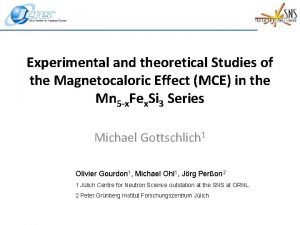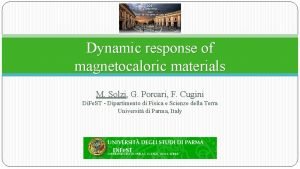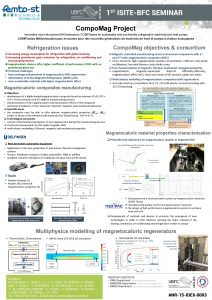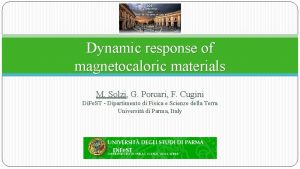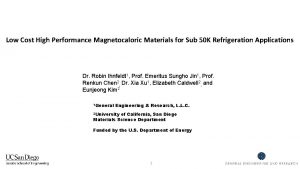Magnetocaloric effect The magnetocaloric effect hereafter MCE is





















- Slides: 21

Magnetocaloric effect The magnetocaloric effect (hereafter MCE), is the cooling or heating in varying magnetic fields. It may be enhanced in molecule-based materials. Besides the fundamental interest in the MCE properties of novel materials, this effect is of technological importance since it can be used for cooling applications according to a process known as adiabatic demagnetization. Specific heat experiments are particularly suitable for studying the MCE, since this effect is intimately related to thermodynamics. 1

The principle associated of MCE principle of and the adiabatic demagnetization is easily understood: The material, assumed to be a (super)paramagnet with spin S per formula unit, is initially in state A(Ti, Hi), at temperature Ti and field Hi. If we change the magnetic field under adiabatic conditions ( Stot = 0), the magnetic entropy change ( Sm) must be compensated for by an equal but opposite change of the entropy associated with the lattice, with a change in material temperature. 2

If we make an adiabatic field change in the H f < Hi magnetic field from Hi to Hf this brings the system to state B(Tf, Hf) with the temperature change Tad = Tf – Ti (horizontal arrow). If alternatively the magnetic field is isothermally changed to Hf in a reversible process, the system goes to state C(Tf, Hf) with the magnetic entropy change Sm (vertical arrow). It is easy to see that if the magnetic change H reduces the entropy ( Sm< 0), then Tad is positive, whereas if H is such that Sm > 0, then Tad < 0 3

Nanostructured materials made of superparamagnetic clusters are particularly appealing in terms of MCE, because the usually large magnetic moments of the clusters are easily polarized by the applied field providing large magnetic entropy changes. A very interesting situation is represented by molecular magnetic clusters in which a total spin can be defined for each individual cluster as a result of dominant intracluster interactions. Example: Calculated Sm for an isolated magnetic particle with S = 10 and varying axial anisotropy D = 0. 5, 1. 5 and 3. 0 K upon a field change H = (0 -1) T. 4

Supramolecular chemistry provides a potentially attractive way of assembling and maintaining controlled nanostructures. The magnitude of the magnetic interactions between the molecular building-blocks is crucial to determine the properties of such materials. The main parameter in this discussion is the energy level separation between different spin states that gets enlarged by the reduced size of the molecular units. At variance with bulk materials, for which energy levels constitute a continuum band, these systems can be considered in between the classical and quantum world. 5

Specific heat measurements The specific heat C of a given material, that is the heat capacity per unit mass (or mole), is defined as the temperature derivative of its internal energy, C = d. U/d. T. Its determination thus provides integrated information of all the energy levels of the magnetic system. Because in a typical molecular cluster there are energy levels split in the range 1– 102 cm-1 (1 cm-1 = 1. 43 K = 12. 2 e. V), anomalies in the specific heat are easily visible at liquid He temperature. One important feature that characterizes the specific heat technique with respect to, e. g. , magnetization or NMR, is that it can be employed in zero applied field; no magnetic perturbation is therefore introduced in the system. 6

Spin–spin correlations, that is ordering phenomena, are ideally investigated using specific heat experiments. Given the fact that the interaction energies for molecular spins are usually weak, phase transitions may only occur at very low temperatures, typically below 1 K. In these cases, the application of any external—even small—magnetic field may wash out the collective phenomena and the use of a noninvasive technique, such as specific heat, is particularly suitable, if not necessary. The specific heat is also directly related to the magnetic entropy S of the system through the search for . This quantity is currently receiving increasing attention in possible applications of molecular magnets as refrigerant materials. 7

On the other hand, an external magnetic field in the range 10 -1 – 10 T gives rise to a Zeeman splitting of around one Kelvin (8. 6 10 -5 e. V) to a molecular spin, so the anomaly in the specific heat can be consequently shifted in a controlled manner. In addition, the dependence of C on magnetic fields gives information on the magnetic states, i. e. , whether they are ‘‘classical’’ spin states or quantum superpositions of these. Specific heat experiments are currently carried out to detect fine energy splittings in molecular magnets in a versatile way and with an accuracy that is comparable to that of spectroscopic techniques. As we shall see below, specific heat experiments provide a privileged tool to investigate time-dependent phenomena in the quantum regime of such systems. 8

In order to investigate the quantum behavior of molecular spin clusters, all the measurements must be performed at very low temperature. The QD-PPMS, is an automated workstation that allows to perform a variety of experiments requiring fine setting of thermal control in the temperature range 1. 9− 400 K. Using the 3 He refrigerator the temperature available goes down to 0. 3 K. A superconducting coil allows to apply a magnetic field up to ± 7 T. 9

To measure the specific heat it is necessary to read the response of the system in terms of temperature changes after a controlled quantity of heat has been supplied. The instrument apt to realize this kind of experiment is the calorimeter, that essentially is constituted by a platform with an heater to provide the heat Q(t) and a thermometer to read the temperature T(t). Four or more wires hold the calorimeter and they constitute the electrical and thermal link at the same time. For this reason, the size and the material of which these wires are made need to be carefully chosen according to the temperature range and the size of the sample. 10

All measurements are done in High Vacuum (< 10 -5 mbar) to reduce heat transfer by the surrounding gas molecules In principle, the sample should be thermally decoupled from the surrounding, and the experiments can be seriously affected by non-perfectly adiabatic conditions. Actually the wires of thermometer and of the heater, as well as the sample holder, are responsible for thermal leak. Different models can be adopted to study the system. Model 1) The sample, with heat capacity Cs , is thermally linked to thermometer and heater through the sample holder. The empty calorimeter has a small but finite heat capacity Cadd = Cholder + Cthermo + Cheater, where add stands for addenda. 11

In a first approximation, we consider these three objects in excellent thermal contact and linked to thermal bath through a controlled thermal impedance having thermal conductivity K 1. The approach to thermal equilibrium requires that energy is exchanged between the spins and the lattice, which constitutes thermal reservoir. The so-called single-molecule magnets (hereafter SMMs) relax to equilibrium by flipping the macroscopic spins over the classical anisotropy barrier if thermal energy is sufficiently large. Below a certain blocking temperature, the relaxation slows drastically and quantum tunnelling through the anisotropy barrier is seen to contribute to the dynamics of the macroscopic spins. 12

If a controlled heat quantity Q(t) is provided by the heater to the sample and to the holder block the response of the system is given in terms of temperature changes T(t). The relevant quantity is the total heat capacity Ctot = Cs + Cadd. The heat Q(t) also flows to thermal bath through thermal conductivity of the wires so the energy balance for this system is: where the term on the left is the rate of heat dissipated by the heater, the first term on the right is the heat flowing from the system to thermal bath and the second term on the right is the heat used for the temperature variation of the system (sample + addenda). T 0 is the fixed temperature of thermal bath while T 1(t) is the actual temperature of the system (sample + addenda) that is time dependent. 13

Different solutions of previous equation are possible with a convenient choice of thermal conductivity K 1 and of the time dependence of the heat Q(t). 1) If d. Q(t)/dt = Q 0 (t - t 0) (heat pulse at t = t 0 for a very short time) and K 1 is very small (adiabatic condition), the solution is T 1 - T 0 = Q 0/Ctot. Thus, controlling the value of Q 0 and measuring the temperature variation T 1 - T 0 , one may directly estimate the heat capacity Ctot = Q 0/(T 1 - T 0 ). This describes the adiabatic methods and it coincides with the definition of specific heat 14

2) If d. Q(t)/dt = P (t - t 0) (step-like heat signal starting at t = t 0, where P is a constant with dimension of power) and K 1 is finite, then the solution of the equation is T - T 0 = PK 1 -1 exp(-(t - t 0)/t 1, where t 1 = Ctot/K 1 is the relaxation time. This method, known as the relaxation method, it is widely used for automatized measurements. 3) If d. Q(t)/dt = p 0 cos 2( t) (sinusoidal current through the heater with angular frequency ) and K 1 is finite, then the steady state solution is T - T 0 = p 0 (4 C)-1 sin(2 t) + p 0(2 K 1)-1 where is a correcting factors that in optimal condition is close to 1. This method is known as the ac method. It has some drawbacks thus it is preferred when (i) the knowledge of the absolute value is not essential, and (ii) very small heat signals are requested (for instance to detect phase transition anomalies). 15

Organic materials have often a bad thermal conductivity, so the approximation of previous equation is no longer valid. A more realistic model of the calorimeter stage is shown in the figure, where a finite K 2 is considered, that accounts for both the physical link between sample and holder block, and the rate of internal equilibrium of the sample; establishing an internal relaxation time τ2 = Cs/K 2. 16

To this model it corresponds the new equation: where Cp and Tp are the heat capacity and temperature of the platform. Cs and T 1 are the heat capacity and temperature of the sample. To get the solution of this equation one may use curve fitting method (CFM). The procedure is rather complicate. In the limit τ1 > τ2, the temperature rise (or decay) following a heat pulse is essentially given by the sum of two exponentials, when the constant heating power is on or off: 17

Specific heat of molecular antiferromagnetic wheels The specific heat of molecule-based materials is the result of several contributions. Even at cryogenic temperatures the lattice contribution Clatt is still substantial and, since it grows very fast with temperature, at 10 K Clatt becomes already predominant, masking most of the features of the magnetic contribution Cm. Furthermore, the details of the spectrum of the quantized lattice vibrations (phonons) can be quite complex due to the huge number of independent vibration modes. One usually applies the approximation of an idealized simplified crystal with 3 acoustic branches and (3 N - 3) optical branches. The three acoustic branches are treated within the Debye model, giving the so-called Debye contribution CD, while the optical modes are described by the Einstein model giving the corresponding CE contribution. 18

Molecular rings often have a planar shape with an axial symmetry of the spin arrangement. The dominant antiferromagnetic Heisenberg Cr 8: AF, S = 0 exchange coupling between nearest neighbour spin centres, in combination with an even number of spins, provides a singlet ground state at low temperature and zero field for the isometallic wheels. Cr 7 Ni: S-para, S = ½ The appeal of these AF rings comes first from the energy separation between the lowest lying states that range between a few Kelvin and a few tens of Kelvin, so that these levels are well isolated below liquid helium temperature. 19

Attività pratica : Misure del calore specifico di microcristalli di SMM a temperature criogeiche 20

21
 Magnetocaloric
Magnetocaloric Macbeth hamartia quotes
Macbeth hamartia quotes Act 5 scene 5
Act 5 scene 5 No man eat fruit of the hereafter forever
No man eat fruit of the hereafter forever Mce classes
Mce classes Mce rabka
Mce rabka Mce profesión
Mce profesión Marketo user group new york
Marketo user group new york Mce motherboard
Mce motherboard Digital event producer
Digital event producer Chụp phim tư thế worms-breton
Chụp phim tư thế worms-breton Tư thế ngồi viết
Tư thế ngồi viết ưu thế lai là gì
ưu thế lai là gì Voi kéo gỗ như thế nào
Voi kéo gỗ như thế nào Thẻ vin
Thẻ vin Thể thơ truyền thống
Thể thơ truyền thống Các châu lục và đại dương trên thế giới
Các châu lục và đại dương trên thế giới Từ ngữ thể hiện lòng nhân hậu
Từ ngữ thể hiện lòng nhân hậu Diễn thế sinh thái là
Diễn thế sinh thái là Giọng cùng tên là
Giọng cùng tên là Làm thế nào để 102-1=99
Làm thế nào để 102-1=99





















